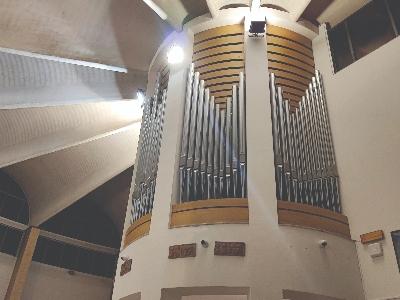
Mascioni Organs, Azzio, Italy; Church of the Santissimo, Crocifisso, Ponte Tresa, Italy
Mascioni Organs of Azzio, Italy, recently completed a new three-manual, thirty-five-stop, electric-action instrument for the Church of the Santissimo Crocifisso at Ponte Tresa, a community on Lake Lugano in the Province of Varese in region of Lombardy, on the Italian border with Switzerland. This is the first pipe organ for this church, which was built in the late 1950s. It is conceived in an Italian symphonic style and yet incorporates features characteristic of the Mascioni firm, which will shortly celebrate its 200th anniversary merely yards from where it was founded.
Equipped by Mascioni’s partners Eltec Industries of Italy, the console boasts sustain and transposing features. The four-rank Solo Cornet, like in many of the firm’s larger instruments such as that at the Shrine of Fatima in Portugal, is composed entirely of harmonic flutes and includes a Septième. The main divisions stand on traditional slider windchests, yet the overall tonal scheme is designed to accompany a choir determined to break the traditional Italian mold. Works by Brahms and Rutter are as commonplace here as well as those by Frescobaldi.
Mascioni was chosen not simply because our workshop is in Azzio, a forty-minute drive away. More crucially, the company’s tonal team has taken on some considerable acoustic challenges in recent years, such as the Fatima shrine’s seven-second reverberation, Tokyo cathedral’s acoustically dry triangular concrete structure, and the Paris Conservatoire’s forty-stop practice organ in a room eight meters square.
The acoustics at Ponte Tresa were equally challenging, the church being in the form of curve-walled, concrete scallop complete with an exceptionally tall, ribbed roof, resulting in a reverberation time of almost six seconds. With that in mind, to keep melodic lines clean and clear, the scales, nicking, and wind pressures are slightly more robust than the Italian norm. The result is a clear, warm, colorful palette that inspires congregations and choir. It was aptly demonstrated by Olivier Latry at the inauguration on November 17, 2023.
Design team: Andrea Mascioni, Daniele Invernizzi; voicer and finisher: Franco Nicora.
Further information: mascioni-organs.com/en/lavena-ponte-tresa/
Manual I – Grande Organo
16′ Principale
8′ Principale
8′ Flauto armonico
8′ Corno Camoscio
4′ Ottava
2-2⁄3′ Duodecima
2′ Decimaquinta
1-1⁄3′ Ripieno IV
8′ Tromba
Campane
Manual II – Recitativo Espressivo
8′ Diapason
8′ Bordone
8′ Viola da gamba
8′ Voce Celeste
4′ Flauto ottaviante
2-2⁄3′ Nazardo
2′ Ottavino
1-3⁄5′ Terza
Ripieno III
16′ Fagotto
8′ Tromba armonica
8′ Oboe
Tremolo
Manual III – Solo
8′ Flauto Traversiere
4′ Flauto a camino
Cornetto IV
8′ Tuba
Pedale
32′ Basso Acustico (fr 16′, 1–12 quinted)
16′ Contrabasso
16′ Subbasso
8′ Basso (ext 16′ Contrabasso)
8′ Bordone (ext 16′ Subbasso)
4′ Ottava (ext 16′ Contrabasso)
16′ Bombarda
16′ Fagotto (Recitativo)
8′ Tromba (Grande Organo)
4′ Clarone (Grande Organo)
Campane (Grande Organo)
Couplers
Solo/GO 16-8-4
Rec/GO 16-8-4
GO/GO 4
Solo/Rec 8
Rec/Rec 16-4
Solo/Solo 16-4
GO/Ped 8-4
Rec/Ped 8-4
Solo/Ped 8-4
Mixture Compositions
Grande Organo Ripieno IV
C1–E17 19 22 26 29
F18–E2 15 19 22 26
F30–C48 12 15 19 22
C#49–C61 8 12 15 19
Recitativo Ripieno III
C1–B12 15 19 22
C13–F54 12 15 19
F#55–C61 8 12 15
Solo Cornetto IV
A20–C61 8 12 flat-14 17

